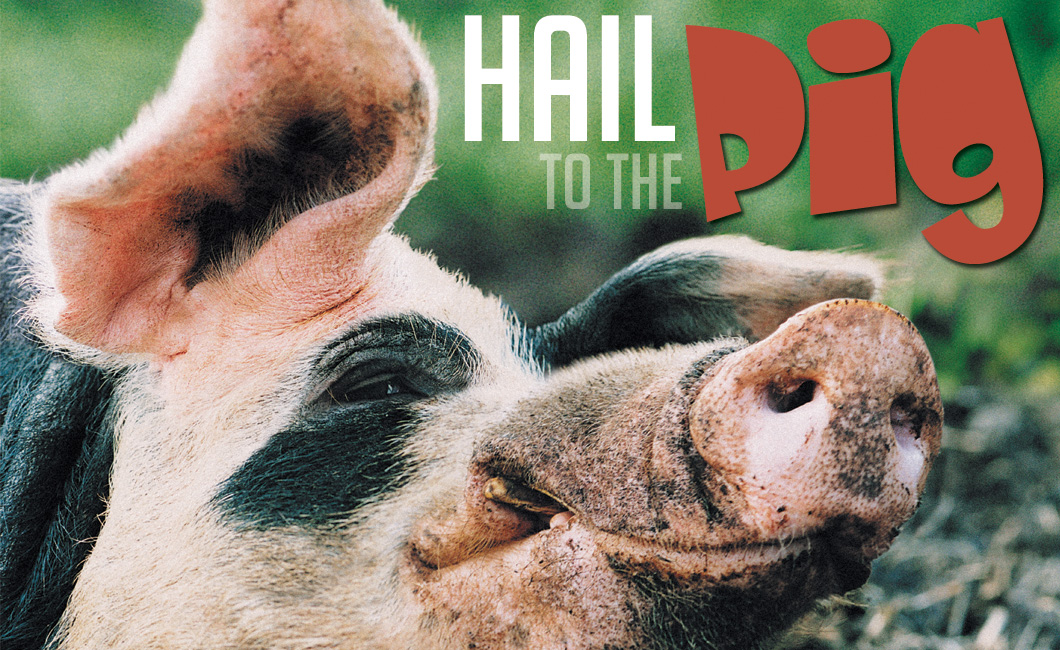- Whether called a pig, swine or hog, a male pig is called a boar and a female pig is called a gilt before having piglets and a sow after.
- Pigs have, at times, both straight and curly tails. When their tails are curly they are said to be happy.
- Pigs like to snuggle and prefer to sleep nose to nose. They are very social and make friends outside their own species. They dream, play, sunbathe and explore.
- Pigs have more than 20 identified vocalizations, including oinks, grunts and squeals, and communicate constantly. Sows also sing to their piglets while nursing.
- Despite such sayings as “pig out” or “eat like a pig,” pigs prefer to savor their food.
- Pigs are naturally clean animals. Given sufficient space, they create a latrine well away from their living area. Only hours after birth, piglets leave the nest to use the latrine. And as they don’t sweat, pigs like to bathe in water (preferred) or mud to keep cool. This also helps to keep them free from pests and other irritants.
- With their extraordinary sense of smell and strong and flexible snout, pigs root about the ground in search of food. This is especially important with wild pigs as the disturbance of the soil spreads plants by dispersing their seeds and creates new areas for plant growth, helping to maintain biodiversity.
- Pigs have a good sense of direction. For this reason pigs used to be kept on ships. They believed if the ship was wrecked the pig would swim toward the nearest shore.
- “[Pigs] have the cognitive ability to be quite sophisticated. Even more so than dogs and certainly [more so than human] 3-year-olds,” according to Professor Donald Broom of the Cambridge University Veterinary School. Professor Stanley Curtis of Penn State University has found that pigs can play joystick-controlled video games and are “capable of abstract representation.”
- Part of the 12-year cycle of animals in the Chinese zodiac, it is considered an auspicious time to be born. Those born under the sign of the pig are said to be very lucky and will be happy and honest. Chinese parents try to plan their child’s birth to occur during the Year of the Pig.
- A herd of aquatic pigs live on the uninhabited island of Big Major Cay. No one is quite sure how they got to the island but they love a free food handout. When they spot a boat heading toward shore they paddle out in the hopes of a treat.
- From literature to comics, nursery rhymes and fairy tales, folklore and mythology, film, animation, television, radio, music, video games, toys and advertising mascots, the pig runs the cultural gamut. Some of the pigs most famous characters include: Wilbur (Charlotte’s Web), Piglet (Winnie the Pooh), Porky Pig (Looney Tunes), Miss Piggy (Muppets) and a bagpipe-carrying gargoyle pig at Melrose Abbey in Roxburgh, Scotland.
Written by Jenifer Chrisman on February 25, 2015.
“I know of no other animals [who] are more consistently curious, more willing to explore new experiences, more ready to meet the world with open mouthed enthusiasm. Pigs, I have discovered, are incurable optimists and get a big kick out of just being.”
– Lyall Watson, Johannesburg Zoo director and biologist
It’s a banner day for pigs. No, really. March 1 of each year celebrates National Pig Day in honor of our underrated and often maligned porcine pals.
Before I say anything further, I have to admit when I saw National Pig Day I immediately thought of my mother-in-law, who is a huge fan of the pig. She has more pig paraphernalia than most people have square footage. At last count it is estimated she has over 3,000 pieces of pig pottery, woodcuts, figurines, plates and even a pig toilet paper roll holder. I lucked out and found that little gem at The Christmas Tree Store.
The pig, who my mother-in-law loves so much, has long been reputed to be gluttonous and slovenly. To help correct this negative reputation and assist in the celebration of the pig, below are some interesting and unusual facts about pigs:
The slovenly reputation pigs have been cast in is based on the overcrowded spaces they are sometimes forced to live in. In a natural environment they are generally very peaceful, loving, socially active, inquisitive and clean.
In the words of Sy Montgomery, The Good Good Pig: The Extraordinary Life of Christopher Hogwood, “I never met a pig I didn’t like. All pigs are intelligent, emotional, and sensitive souls. They all love company. They all crave contact and comfort. Pigs have a delightful sense of mischief; most of them seem to enjoy a good joke and appreciate music. And that is something you would certainly never suspect from your relationship with a pork chop.”
Sources:
www.onekind.org/be_inspired/animals_a_z/pig/
www.peta.org/blog/top-ten-fascinating-facts-pigs/, think-differently-about-sheep.com/pig_facts.htm
en.wikipedia.org/wiki/List_of_fictional_pigs,_listverse.com/2013/09/04/10-awesome-facts-about-pigs/



